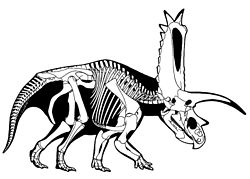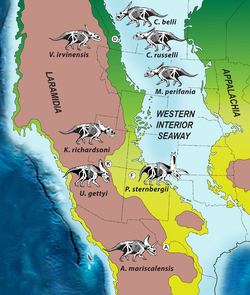Kirtlandian
| Kirtlandian Faunal range: Cretaceous, 74.8–72.8 Ma |
|
|---|---|

Pentaceratops sternbergii or Titanoceratops ouranos skeletal restoration
|
|
| Type | Land-vertebrate age |
| Sub-ages | Hunter Wash local fauna, Willow Wash local fauna |
| Included formations | |
| Older age | Judithian |
| Younger age | Edmontonian |
| Area | New Mexico |
| Thickness | 691 to 701 metres (2,270 to 2,300 ft) |
| Index Fauna | |
| Principal | Pentaceratops sternbergii |
| Other | , Kritosaurus navajovius, Melvius chauliodous |
| Lithology | |
| Primary | sandstone, coal |
| Other | siltstone, mudstone, shale |
| Location | |
| Coordinates | 36°18′N 108°30′W / 36.3°N 108.5°W |
| Region |
|
| Country | US, Canada, Mexico |
| Type section | |
| Named for | Kirtland Formation |
| Named by | R.M. Sullivan & S.G. Lucas |
| Year defined | 2003 |
| Location | San Juan Basin |
| Coordinates | 36°12′N 108°06′W / 36.2°N 108.1°W |
| Region | New Mexico |
| Country | US |
| Thickness at type section | up to 701 metres (2,300 ft) |
 Map of Kirtlandian North America, F marking the San Juan Basin |
|
The Kirtlandian is a North American land-vertebrate faunal age of the Cretaceous period, following the Judithian and succeeded by the Edmontonian. It lasted about 2 million years, ca 74.8 to 72.8 Mya and is characterized by the ceratopsian Pentaceratops sternbergii, which lived throughout the Kirtlandian. It was first named by R.M. Sullivan and S.G. Lucas in 2003 as a faunal age for the Kirtland and Fruitland formations. Previously, only five land-vertebrate ages were identified from the Late Cretaceous. as identified by Loris S. Russell in 1975, they include the Paluxian, Aquilan, Judithian, Edmontonian, and the Lancian. Before the naming of the Kirtlandian, three gaps, between the Paluxian and Aquilan, the Aquilan and the Judithian, and the Judithian and Edmontonian, were identified but not named.
The Fruitland Formation measures 97 to 107 metres (318 to 351 ft) thick, and with the 594 metres (1,949 ft) of the Kirtland Formation, the Kirtlandian consists of 701 metres (2,300 ft) of sediments. The rock types within the formations are primarily coal beds, but also include sandstone, siltstone, mudstone, and shale. Within the sediments with a Kirtlandian age, two local faunas, the Hunter Wash local fauna, and the Willow Wash local fauna, have been identified. The currently accepted date of the Kirtlandian is 74.8 to 72.8 million years ago.
The Kirtlandian is an age of fauna that lasted for 2 million years. It is Campanian in age, and is placed between the Judithian age, which is characterized by older taxa, and the Edmontonian faunal age, characterized by the appearance of Edmontosaurus regalis and Pachyrhinosaurus canadensis. The geological formations found to date or persist from the Kirtlandian are the Bearpaw, the upper Kaiparowits Formation, the Kirtland, Fruitland, Williams Fork, Fort Crittenden, Ringbone, Corral de Enmedio, Packard, and El Gallo formations, and possibly the lower part of the Cerro del Pueblo Formation and upper region of the Aguja Formation. These formations are exposed in Alberta and Montana, Utah, New Mexico, New Mexico, Colorado, Arizona, New Mexico, Sonora, Baja California, Baja California, and possibly Coahuila, and Texas, respectively.
...
Wikipedia
